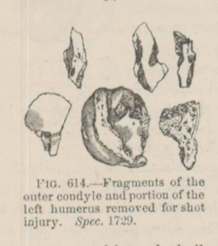Title: Allen, J.
Source text: The Medical and Surgical History of the War of the Rebellion. (1861-65.), Part 2, Volume 2 (Washington, DC: Government Printing Office, 1876), 862.
Civil War Washington ID: med.d2e31341
TEI/XML: med.d2e31341.xml
CASE 1791.—Private J. Allen, Co. G, 9th New York Cavalry, was wounded in engagement at the Rapidan River, September 14, 1863. Surgeon W. H. Rulison, 9th New York Cavalry, recorded his admission at the field hospital of the 1st division, Cavalry Corps, with: "Gunshot fracture of left arm." On the following day the wounded man entered Armory Square Hospital at Washington, where Surgeon D. W. Bliss, U. S. V., in charge, performed excision at the elbow joint. The details of the case he reported as follows: "The patient was wounded by a pistol bullet entering immediately over the external condyle of the left humerus, fracturing the condyle, passing downward, and opening the elbow joint. He was admitted to the hospital on September 15th, and a portion of the condyle removed by the chain saw, and several loose fragments taken out, the incision through the muscles being of an S-shape; patient under ether. The ball remains in the arm. After the operation cold water was applied continuously, and opiates given when necessary to relieve pain. The whole arm became greatly swollen the ensuing day, yet not very painful; tongue moist; pulse full and regular; appetite tolerably good; wound secreting healthy pus. He was, however, unable to void his urine, which was drawn off by the catheter—an operation which had to be frequently repeated during his illness. On the 18th, cold water as an application to the arm was omitted as it appeared to increase the pain, and warm-water dressing was substituted. The latter was also discontinued for a like reason, and from that time onward the limb was kept wet with a lotion composed of acetate of lead one drachm, pulverized opium half a drachm, and water one pint, and the wound itself with a solution of permanganate of potassa one-half drachm in one pint of water. From the 16th his symptoms became more unfavorable, having daily two and sometimes three rigors, followed by increased heat of body and profuse sweats. On the 26th, wound secreting a greenish and very offensive pus; pulse frequent and sometimes intermittent; skin dry; conjunctiva yellow; tongue dry with brown fur in centre; no appetite; urine of dark amber color; bowels constipated. The bowels were opened by podophyllum half a grain, and extract of colocynth eight grains. Sulphate of quinine was given daily, as it had been from the commencement of the rigors, and opium also to relieve pain; sweet spirit of nitre and spirit of mindererus in proper doses when the skin was hot and dry. Milk punch and beef essence were freely administered, and every proper article of diet which he imagined he could eat, such as chicken, chicken broth, &c., was procured and given to him. Free incisions were made from time to time to evacuate pus, which unavoidably found its way beneath the muscles of the arm. On the 30th hæmorrhage occurred, which was, however, readily controlled by pressure. He continued to sink hourly, and died at 10½ o'clock A. M., October 1, 1863." The specimen, represented in the annexed cut (FIG. 614), consists of six fragments, embracing the outer condyle and the adjoining portion of the left humerus. It was contributed by the operator.
